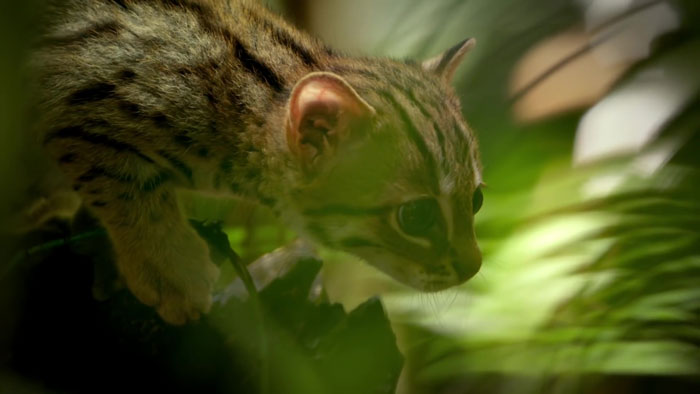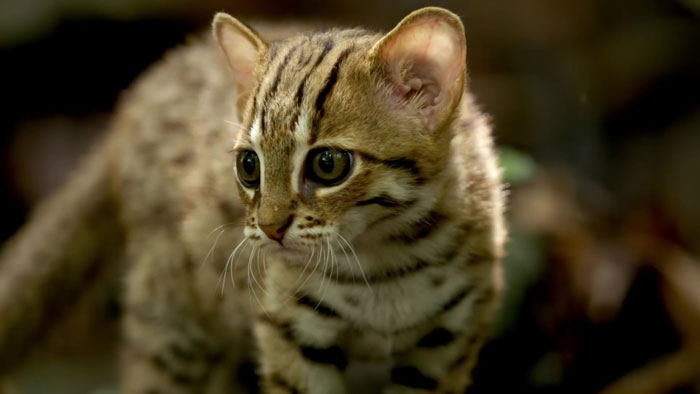
This Is The World’s Tiniest Wild Cat, And It Might Be The Cutest Thing You’ll See Today
Nature is a fantastic place for fresh air and sunshine. Nature is also great for your mental health, as being in it reduces stress and anger. But did you know that nature is also a significant source of cuteness?
Yes, forests, jungles, deserts, and several other natural locations are home to millions of cute animals—koalas, llamas, alpacas, possums, spooders, slow lorises, polar foxes, harp seals, and a myriad more. In this list, it’s, of course, the rusty-spotted cat, which is incidentally also the smallest wild cat on the planet.
Meet the smallest feline species on the planet—the rusty-spotted cat
Image credits: BBC
BBC has recently come out with a preview of its latest episode of Big Cats. It features a near-adult rusty-spotted cat that lives in the wilds of Sri Lanka. The rare cat is seen roaming the woods and jumping over water, searching for food, and exploring the premises. And it’s adorable!
Bored Panda contacted Danielle Miles, a wildlife researcher in Nevada working on faunal response to conifer removals who is currently doing her doctoral degree while also instructing classes (such as Conservation Biology). Miles has previously done research on carnivores and animal behavior, including the rusty-spotted cat, and agreed to elaborate on the wild animal species for our readers.
Image credits: BBC
The rusty-spotted cat (prionailurus rubiginosus) is a wild species of unusual cats living in the forests of Sri Lanka and much of India, with sporadic sightings in Terai and Nepal.
Danielle Miles wrote for the Animal Diversity Web on the rusty-spotted cat during her undergraduate years at university: “The way that the Animal Diversity Web used to work was from a list of species that needed to be updated. Then, through approved universities and advisors, people could volunteer to write up the page for the species needed. At the time, I was an undergraduate researcher working in two labs, one on Spotted Hyenas and one more generally on carnivore evolution. So, when I saw that the Rusty-spotted cat was one of the species that still needed an account, I took the opportunity.”
Measuring at 35-48cm in body length, the adorable wild cat can easily fit into human palms
Image credits: BBC
These tiny cats are predominantly nocturnal, though they do come out briefly during daylight. However, their activity during the daytime is somewhat limited. Rusty-spotted cats often hide in trees and caves to avoid larger predators in the area.
Rodents and birds are, as you may have expected, their main course when it comes to this cute cat’s meals. However, if need be, they also dart after other small prey, such as lizards, frogs, and insects. Much of the rusty-spotted cat’s cuteness comes from its coat and size. The rare animals are often described as a smaller version of a leopard, sporting a rust-colored coat and fewer, but still present, spots. The average rusty-spotted cat measures around 35–48cm in body length, as well as another 15–30cm of tail length. It could easily fit in your hand if it were to curl up.
Many people online were interested in whether it was possible to domesticate the adorable animal. However, Miles elaborates on whether they should actually be brought into people’s homes: “In short, no. An easy way to predict the outcome of people buying rusty-spotted cats is to look at the fate of other species in similar situations. How many other wild cat species, bears, alligators, and the like have had domestication attempts, only to land hundreds to thousands of animals in rescues living incomplete lives as they cannot re-acclimate to a free life?”
Image credits: BBC
“Perhaps the closest examples to the Rusty-spotted cat to draw upon are actually lemurs and other small primates,” continued Miles. “People are attracted to the idea of species like these as pets because they are cute and intelligent, and their size makes them seem manageable and less dangerous. Yet, the truth is that these situations do not work out, and the animals end up being euthanized or, if lucky, put in a rescue like Lemur Island.”
Like the American bison, the black capuchin, the red-fronted lemur, and several other wild animals, the rusty-spotted cat is also on the list of near-threatened species. The leading cause is that its natural habitat the deciduous forests is declining due to cultivation and natural loss.
Rusty-spotted cats can be found throughout Sri Lanka & India
Image credits: BBC
We’ve asked Miles what can be done to help the rusty-spotted cat avoid extinction. She had this to say: “No specific conservation plans are targeting just the rusty-spotted cat that I am aware of currently, but a focus on preserving their natural habitat and protecting more space from development is key. Protections for unaltered landscapes would not only benefit the Rusty-spotted cat into the future but would provide habitat for all species in those ecosystems, some of which have surely not yet been discovered.”
“The threats to rusty-spotted cat populations are the same that have caused declines in many species across terrestrial landscapes—habitat loss and limitations to their natural ranges and movements,” explained Miles. “As human populations continue to skyrocket, especially in India, developed areas continue to grow and sprawl into areas that were previously forest habitat. In addition, the spread of roads and agricultural land has led to increased sightings of Rusty-spotted cats in more human-dominated landscapes.”
“However, I do think that the growing intrigue for the Rusty-spotted cat can be put to good use for conservation,” explained Miles. “These are especially fascinating creatures due to their size and relative novelty to the general public. I would encourage anyone who has now found themselves enthralled with the Rusty-spotted cat to find helpful ways to fuel their passion.”
Image credits: BBC
Supporting zoos and conservation organizations can help in turning the tide that is threatening the rusty-spotted cat: “I know a few major zoos like the San Diego Zoo and Berlin Zoo have Rusty-spotted cats. Visiting and sponsoring animals at credible conservation organizations like these can allow close interactions with the species while maintaining respect and funding for their wild counterparts,” said Miles.
“It was just a few years ago that the Berlin Zoo had its first successful breeding program for Rusty-spotted cats and these are not sold to private individuals, so anyone attempting to buy a Rusty-spotted cat for their home has to know that these animals are being stolen from their natural habitats, likely from their mothers so they are young enough to acclimate to human interaction.”
Miles also explained that another option is to volunteer at local zoos or animal rescues. The rusty-spotted cat is relatively rare, sure. Still, people will find that giving their time and energy to these organizations will be a great learning experience and much more rewarding.
Unfortunately, the rusty-spotted cat is also on the list of near-threatened species
Image credits: BBC
“Secondarily,” continued Miles, “with any species that is newly interacting with humans, there is the concern of zoonotic diseases. Zoonotic diseases are those spread between humans and animals and many of our most deadly outbreaks come from this type of transmission, for example, SARS and Ebola outbreaks in recent history. Bringing Rusty-spotted cats into human homes, especially with the presence of other species they would not encounter in nature, dramatically increases the risk of spreading disease and the likelihood that these potentially deadly outbreaks are diseases we have never seen or treated before.”
Before you go wondering well, who’s the second smallest feline in the world? It’s the black-footed cat. Even though it’s not the smallest, it is attributed to the title of the deadliest cat on earth because of its ability to bring down more prey than any other feline. Also adorably tiny, also up there with all of the cute animals.
Here’s a video of the rusty-spotted cat roaming wild in its natural habitat
132Kviews
Share on FacebookIt's good that there is a cute species to help draw attention to dangerous habitat fragmentation in the region.
So, there is a cat that stays a kitten forever and why is there not one in my home?
I'm reading that they are easily domesticated, playful and affectionate. How is this not a common pet?
Load More Replies...It's good that there is a cute species to help draw attention to dangerous habitat fragmentation in the region.
So, there is a cat that stays a kitten forever and why is there not one in my home?
I'm reading that they are easily domesticated, playful and affectionate. How is this not a common pet?
Load More Replies...
 Dark Mode
Dark Mode 

 No fees, cancel anytime
No fees, cancel anytime 
























































298
31